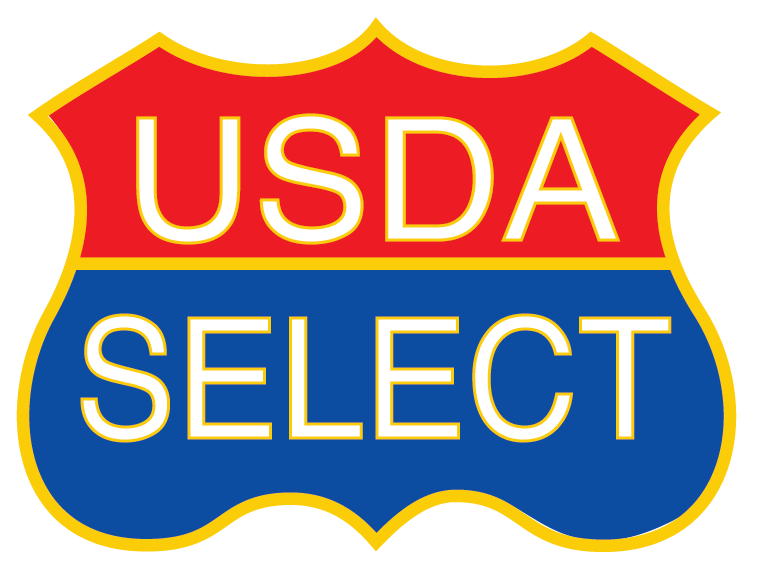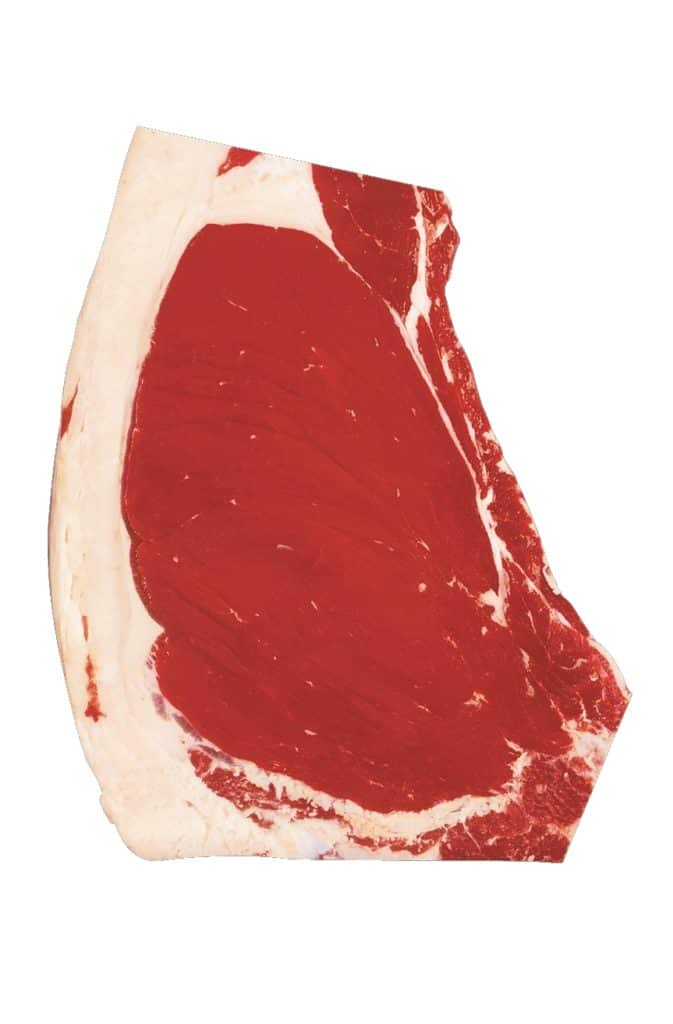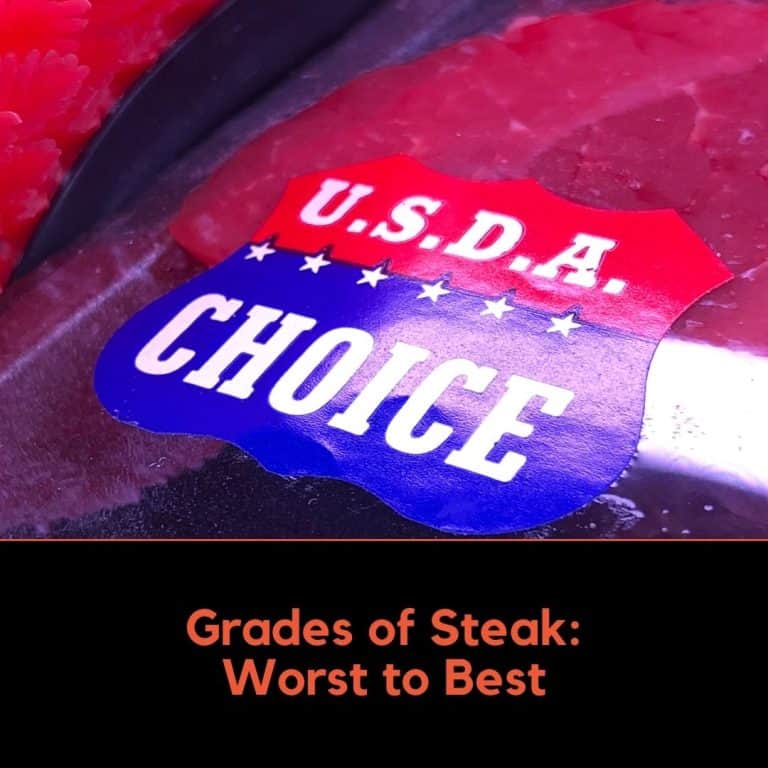As a reminder of where this knowledge comes from. I was a restaurant Chef for over 25 years. During that time I also participated in a program hosted by Texas A&M called Beef 101. You follow the animal from the feedlot, through processing, and then into the butcher lab. It was an amazing experience and even though I took in a great deal of knowledge, I felt like I needed to take the class 10 more times to be able to absorb everything. If you ever have the opportunity to participate in something similar I would highly recommend it. We have lost touch with the foods we consume. When everything comes out of a neatly packaged box, it’s easy to forget where it came from.
The Grades of Steak
United States Department of Agriculture, or the USDA, created a system that gave quality grades to beef, think of it as a beef rating. The USDA beef grades you will find at the market are Prime grade beef, Choice Beef, and Select Beef. The lowest beef classification is Canner… I will let you figure out what that gets used for.
If the steak does not have a USDA-graded stamp it is referred to as a no-roll. This process of grading the animal happens just after slaughter.
The beef is split between the 14th and 13th ribs so they can see the intramuscular fat that marbles the ribeye. The degree of marbling and the size of the ribeye are two factors that will then determine the grade and if the animal is eligible for a Certified Beef Program. In the field, ranchers perform a quick yield grade by assessing the amount of fat on the outside of the animal along its back. They are not surprised by the grade and its program when it goes to processing.
USDA Certified Programs
What gets confusing is when you have Certified Beef Programs that come into play. The first of such programs is Certified Angus Beef or CAB. The purpose is to designate a quality standard higher than the normal USDA grading system. This all came about because of huge inconsistencies in the steaks you found at your local grocery store. Certified Angus Beef wanted people to know that they were getting the best steak, or whatever cut of meat, possible when shopping. When CAB started in 1978 it was the first USDA certified beef program. As of this writing, there are now more than 145 certified beef programs. Like many good things marketing has done for us, it has once again made things confusing. Take a look at the chart from the USDA that compares some of the programs and what makes them different.
Are The Expensive Cuts Worth It
It all depends on what you are going to do with it. A prime London Broil that’s going to simmer with a bunch of vegetables and broth is not worth the additional cost. Higher grades of beef should be reserved for cooking preparations that require the least amount of adulteration so the meat can be the star. Although not every day an everyday grade of beef, wagyu is a treat when properly prepared.
Common Steaks at my local store (not ranked)
Quick Note: To rank steaks from best to worst would be incredibly biased. I don’t know your personal preference, or your budget. You may prefer the hanger steak vs filet mignon, like I do. So my goal here is to help you understand each cut so you can make your own decision and eventually find your ideal cut.
Popular Cuts of Beef are usually the more tender cuts. Some have different names created by marketing companies to make you feel like you are getting something different or better. The most famous example is the Denver Steak. The name is trademarked by the National Cattleman’s Beef Association. Cattle only have so many muscles, so anything “new” is just a marketing gimmick to charge you more for something you were already buying. Manhatten Filet anyone? That’s a thick cut NY Strip that is then cut in half to resemble a Filet. Does it cost more? You bet it does.
Round Steak
The round is best used for long and slow braises and not as a steak. The round comes from the rear leg of the cow and is full of connective tissue that needs time and temperature to become tender.
Top Sirloin
Also called a Coulotte or Pichana. Sirloin steak cut from the top sirloin will not be the most tender of steaks but is going to be flavorful. For the price, this is the best option when you do not want to splurge on the more expensive cuts.
Flap Steak
This is not a common steak to find at either a restaurant or your local butcher shop. The flap looks similar to a skirt steak but much larger. It can also be found under the name Bavette. This cut is tender and has a very intense beef flavor.
T-Bone Steak
Cut further up on the short loin, a T-bone will have a much smaller filet than its big brother porterhouse. The main attraction here is the bone in the New York Strip with a little bit of filet.
Porterhouse Steak
This bone-in steak is cut from the rear of the short loin resulting in a larger tenderloin and strip steak. It is the big brother to the T-Bone steak.
New York Strip Steak
The NY Strip lands in a solid 3rd place in rankings for high-end restaurants. It is my preferred steak as I like the chew to it over a Ribeye or Filet. I find a NY Strip to be best cooked to Medium Rare. The strip loin is also the primary steak in both T-Bones and Porterhouse steaks.
Ribeye Steak
When you start with the whole bone-in primal it is called an Export Rib. When you roast this whole and slice it into steaks you have Prime Rib. If you cut the export rib down into steaks you now have a bone in ribeyes or Cowboy ribeyes. Long bone ribeyes are called tomahawks and when the rib bones are removed you have the boneless ribeye steak. Even though it is called Prime Rib it does not always use Prime Beef. This section is by far the most prized section of the entire animal. Ribeyes have a good amount of marbling. This is not a good steak for someone that wants a leaner cut. If you do not like fatty or rich steaks there is a better choice.
Filet Mignon
Almost exclusively sold as a boneless cut, you can occasionally find a bone in filet on restaurant menus. The filet is cut down from the beef tenderloin. This is one of the most tender cuts on the animal as well as one of the most expensive. When the larger end of the tenderloin is sold as a steak it is called a Chateaubriand. Great for small dinner parties, this is the prime rib version of the tenderloin.
Flank Steak
The flanks are pretty flat and lean. They can be tough if not cooked long enough and then cut properly. In restaurants, you will find this steak pre-cut and fanned out so that you can not cut it in the wrong direction. When cut with the grain a flank steak is very chewy.
Flat Iron Steak
I enjoy flat irons more so than flank steaks. Flat irons have more marbling and to me, that just makes for a better eating steak. The only downfall to these cuts of beef is that they do have a nerve that runs through them towards one end. There is nothing you can do to tenderize this part, so you will have to work around it. Even with that drawback, I will still take this steak over the flank.
Hanger Steak
Very tender and with decent marbling. Hanger steaks are also best served pre-cut, against the grain, to prevent claims of toughness or stringiness. Unlike other tender cuts of steak, the Hanger steak has a pretty loose muscle structure which makes it tender. This is an underutilized cut of beef. If you are looking for a steak that you can slice and serve compare the hanger steak vs flank steak to find your perfect fit.
Skirt Steal
There are two sides to a skirt. The inside skirt has thicker connective tissue requiring more cooking to be tender. The outside skirt, which is also larger, has a good amount of marbling and is more tender. The outside skirt is better suited for cooking to medium rare while the inside is a good idea to use for fajitas.
The Grades of Steak Ranked from Worst to Best
Utility, Cutter, and Canner
These grades of beef are rarely seen at a grocery or butcher shop. They are used primarily in processing for making ground beef, canned soup, and frozen ready made dinners. The biggest factor here as well with Commerical grades is the age of the animal at processing.
Standard and Commercial
These two grades will usually be sold as ungraded or as store branded steak. Next time you are at a big box chain grocer and you do not see a grade clearly labeled on the packaging this is what you are getting.
Select
This grade will be uniform but will have significantly less marbling than choice. In general, it just will not have the same flavor, tenderness, or experience as a higher grade.
Choice
This is the grade of choice for most all restaurants serving steaks. It will have a decent amount of marbling and is your best choice when prime is not an option. Most all, including Certified Angus Beef, will fall into the choice grade beef.
Prime
This is the highest graded quality steak you can find. It will have high levels of marbling making it very flavorful compared to any of the grades below it. There is a significant price jump to this quality and the extra cost does not always make it worth it.






American Wagyu
Wagyu in the US has come a long way over the last few decades. They do not follow the same Japanese grading system but rather have their internal grades. Snake River Farms which happens to be the pioneer for American Wagyu has two grades. Black is the lower tier and Gold is the best of the best. Both of these grades are better than a USDA Prime steak as the level of marbling is significant.
Japanese Wagyu
Japan has its grading system that begins with a letter then followed by a number. A, B, and C are the yield grades, and then numbers 1 to 5 are the marbling score. A5 is the highest possible quality ranking possible. An A5 will be sold by ounce and be quite expensive. Frequently it will also be sliced thin and served as you would sashimi. Japanese Wagyu is a superior animal in every way. The fat has a lower melting point causing a raw thin cut of beef to almost dissolve in your mouth. Do not expect to find this at your local supermarket.
Summary
A lot of information is contained here. Hopefully, some of it is new and will help you next time you head to the market. It should be a simple part of your day but our marketing friends have found a way to confuse us all in hopes that we buy their steaks thinking they are better in some way. The reality is, it’s probably the same steak but just with an extra $1 added on to pay for the marketing. Explore new cuts and take your time shopping. When possible shop at a local butcher or talk with the butcher in the market. They know their steaks and will be more than happy to direct you to the best cuts of steak for you.

